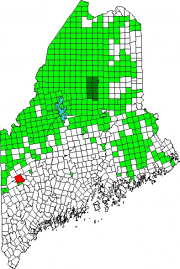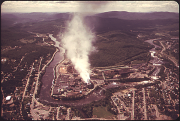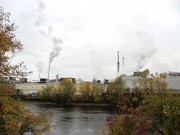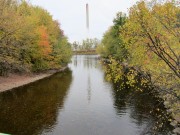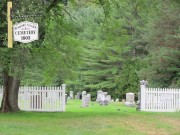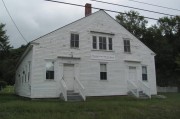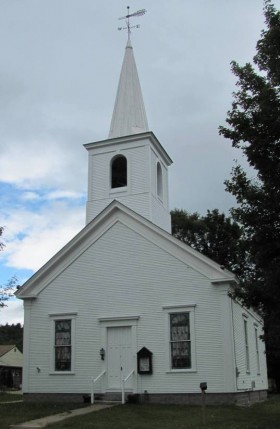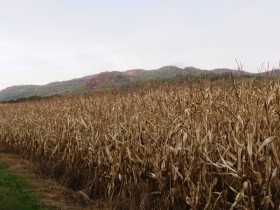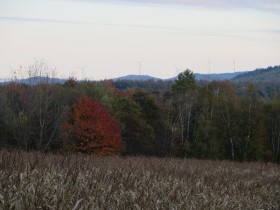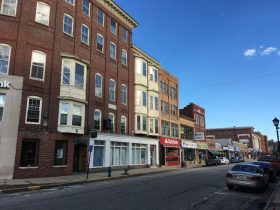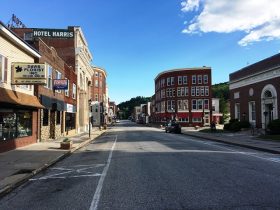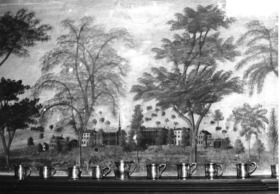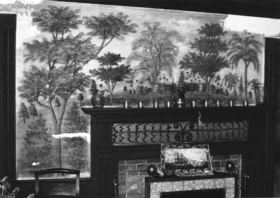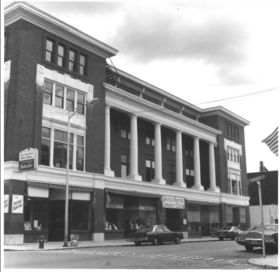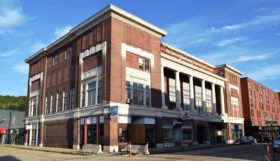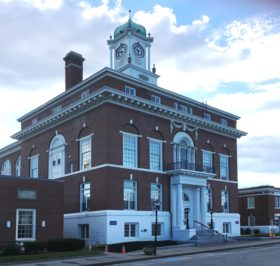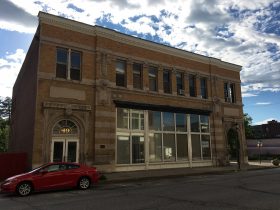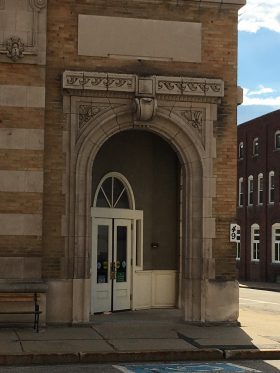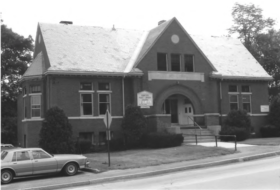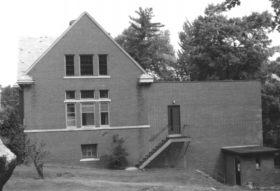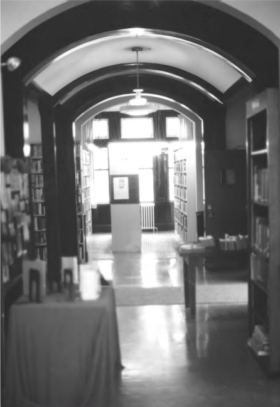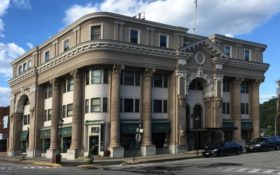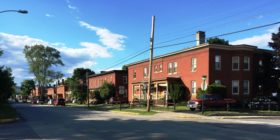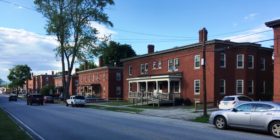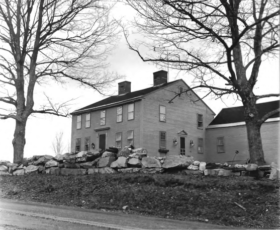
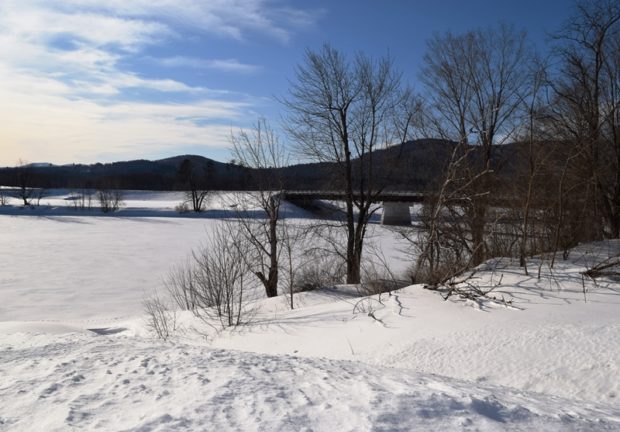
| Year | Population |
|---|---|
| 1970 | 9,363 |
| 1980 | 8,240 |
| 1990 | 7,078 |
| 2000 | 6,472 |
| 2010 | 5,841 |
| Geographic Data | |
|---|---|
| N. Latitude | 44:31:19 |
| W. Longitude | 70:35:50 |
| Maine House | District 115 |
| Maine Senate | District 18 |
| Congress | District 2 |
| Area sq. mi. | (total) 69.9 |
| Area sq. mi. | (land) 68.6 |
| Population/sq.mi. | (land) 85.2 |
| County: Oxford
Total=land+water; Land=land only |
|
[RUM-frd] a town in Oxford County, first settled in 1782. It incorporated on February 21, 1800 from New Pennycook (or Pennacook) Plantation.
The town later annexed land from Peru and Franklin Plantation.
The main village is across the Swift and Androscoggin rivers from Mexico. U.S. Route 2 and Maine Routes 120 and 232 serve the community. A huge paper mill dominates the skyline, although it has seen few workers in recent years.
Several smaller villages dot the landscape: North Rumford, South Rumford, Rumford Point, and Rumford Center. Adjacent to the old Meetinghouse at Rumford Center is the Center’s equally old cemetery.
Pennacook Falls plunge 180 feet over solid granite into the Androscoggin River that flows past the main settlement in Rumford.
The water power here has driven paper mills for decades. In addition, the Swift, Ellis, and Concord rivers enter the Androscoggin in the town.
Varney’s Gazetteer of Maine described the scene in 1886:
Wheat, corn, oats and potatoes are the crops chiefly cultivated, and yield well. The principal village is East Rumford on the Androscoggin in the eastern part of the town. There are here three saw-mills manufacturing long and short lumber, a shovel-handle factory, a grist-mill, a cheese and a starch factory. On or near Concord River (Rumford Post-Office) are saw, grist and shingle mills. About 3 miles above Rumford Point is a paint mine,– formed by deposit from a spring of ocherous red oxide of iron. Near this is a considerable deposit of iron ore.
These two churches, barely three miles apart on the Androscoggin River, apparently used the same plans to design their buildings.
In the late 19th century a steamboat ran from below the falls and down the Androscoggin to the town of Canton, where passengers and freight could connect with the Buckfield and Rumford Railroad. A ferry operated at Rumford Point across that river at least through the 1930s.
Hugh J. Chisholm opened the Oxford Paper Company’s Rumford mill in 1901 and expanded production in the years immediately following, resulting in a population boom in the town.
The decline in the paper industry is demonstrated by the continuous drop in the town’s population over the past four decades to only sixty-two percent of its 1970 level. But the downtown infrastructure, with its elegant historic properties, remains intact and well kept. Route 232 makes a short loop though the rural southeast of the town.
Former Maine governor and U.S. Senator, Edmund S. Muskie, later to be U.S. Secretary of State was born here in 1914. Rumford is also the birthplace of Lucia Cormier, a state legislator and Democratic Party candidate for the U.S. Senate opposing Margaret Chase Smith in 1960. Smith won reelection.
Form of Government: Town Meeting-Select Board-Manager.
Additional resources
Source: photo “Ferry at Rumford Point,” courtesy of Maine State Archives, George French Collection.
EPA photo from the National Archives, # NWDNS-412-DA-8221
Bennett, Randall H. The Mount Zircon Moon Tide Spring: An Illustrated History. Bethel, Me. c1997.
Gould, Daniel. The History of Rumford, 1826. Rumford, Me. Pennycook Press. 1975.
International Paper Company. Photograph Albums. [19–?] (Cataloger Note: Albums containing photographs taken at various paper and pulp mills in Maine belonging to the International Paper Co. Included are the Umbagog mill, Riley mill, Rumford Falls mill and Otis mill. Two photographs of the Continental Paper Bag Co. in Rumford Falls, Maine, are also included.) [University of Maine, Raymond H. Fogler Library, Special Collections]
Lapham, William Berry. History of Rumford, Oxford County, Maine, from its first settlement in 1779, to the present time. Augusta, Me. Press of the Maine Farmer. 1890.
Leane, John J. A History of Rumford, Maine, 1774-2000. Topeka, KS. Josten’s Printing and Publishing 2005. [Maine State Library]
Martin, Stuart F. New Pennacook Folks: A Historical Record of the Town of Rumford and the People who Lived Here. Rumford Point, Me. S. Martin. 1980.
*Maine. Historic Preservation Commission. Augusta, Me. Text and black & white photos from National Register of Historic Places: http://pdfhost.focus.nps.gov/docs/nrhp/text/xxxxxxxx.PDF and http://pdfhost.focus.nps.gov/docs/nrhp/photos/xxxxxxxx.PDF
Varney, George J. A Gazetteer of the State of Maine. 1886. pp. 483-486.
Virgin, William W. Account Book, 1807-1819. (Cataloger Note: Account book of a general store in Rumford, Maine. William W. Virgin of Rumford, Maine was the owner of a general store.) [University of Maine, Raymond H. Fogler Library, Special Collections]
National Register of Historic Places – Listings
Photos, and edited text are from nominations to the National Register of Historic Places researched by Maine. Historic Preservation Commission.
Full text and photos are at https://npgallery.nps.gov/nrhp
Deacon Hutchins House
 [northwest of Rumford on Maine Route 5] Architecturally, the Deacon Hutchins house is a finely restored example of a very early 19th century farmhouse whose ample proportions denote the substantial position of its first owner. Its primary significance lies in the stunning frescoes by Rufus Porter (1792-1884) that adorn the front parlor. Porter also painted the paneling and wainscoting in the room including a primitive bit of graining over the fireplace. He also decorated the doors in the room employing a type of candle-smoke graining or patterning that is most effective.
[northwest of Rumford on Maine Route 5] Architecturally, the Deacon Hutchins house is a finely restored example of a very early 19th century farmhouse whose ample proportions denote the substantial position of its first owner. Its primary significance lies in the stunning frescoes by Rufus Porter (1792-1884) that adorn the front parlor. Porter also painted the paneling and wainscoting in the room including a primitive bit of graining over the fireplace. He also decorated the doors in the room employing a type of candle-smoke graining or patterning that is most effective.
Deacon Hezekiah Hutchins was born in Hampstead, New Hampshire in 1771. He was the son of Major Hezekiah Hutchins a distinguished soldier who served at Louisbourg in 1745 and in major engagements during the Revolution including Bunker Hill and Saratoga. In 1801, Hutchins with his wife and four children moved to Rumford where he lived until his death in 1856. He was one of the founders and first Deacon of the Congregational Church at Rumford Center. His stature in the town is reflected by his election in 1810 as moderator of the town meeting, in 1821 as collector and constable and his appointment in 1827 as justice of the peace.
The frescoes were executed about 1840 by Porter, then at the height of his career as an itinerant muralist. Beyond his artistic achievements he was a personal embodiment of the era of travel adventure, of free wheeling invention, of scientific, journalistic and artistic enterprise. He was a New England farmer’s son and shoemaker’s apprentice who explored the world on all levels: voyaging to the Hawaiian Islands, becoming America’s leading mural painter, founding the Scientific American magazine, designing an automobile and an airship planned for travel at one hundred miles an hour. His was a life that embodied the spirit and force of 19th century America. Porter also painted the paneling and wainscoting in the room including a primitive bit of graining over the fireplace. He also decorated the doors in the room employing a type of candle-smoke graining or patterning that is most effective.* [Frank A. Beard photos]
Mechanic Institute
[50 Congress Street] The Mechanic Institute is a large, four-story block built of brick with concrete trim. The most distinctive feature is a Doric colonnade at second and third floor level which covers the recessed central bays on one side of the building.
As part of the early industrial paternalism displayed in the erection of Strathglass Park, the Mechanic Institute was organized by the Rumford Falls Power Company as a benevolent and educational association for the mill workers. The building was designed by Miller and Mayo, a prominent Portland architectural firm, to have stores at the street level with the Institute and other office space on the three upper floors.
The building, formerly called The Rumford Mechanic Institute, was built and dedicated in 1911. It was founded by Hugh J Chisholm and financed by the Oxford Paper Company. In 1968 the Oxford Paper Company gave the building and land to the Rumford Mechanics Institute Association. The facility was created “to furnish the wage earners of Rumford the best quality of physical and mental, social and moral improvement, at the lowest cost.” In 1972, The Rumford Mechanics Institute was renamed the Greater Rumford Community Center. * [Frank A. Beard B& W photo, 1978]
Municipal Building
[Congress Street] The Municipal Building is 2½ stories tall with full basement and clock tower. Construction is of brick with granite trim. Growth of the Town of Rumford in the early years of the second decade of th2 20th century was such that the town meeting outgrew its former location. At the 1915 town meeting an initial $25,000 was appropriated for a new municipal building. Designed by Harry S. Coombs, the impressive Colonial Revival structure was completed the following year at a cost of $95,000. This structure like others on the Register downtown reflects the aspirations of a community that viewed the future with abounding confidence.*
Rumford Commercial Historic District
THE COMMERCIAL DISTRICT
The Rumford Commercial Historic District is one of the few planned company towns in Maine. As the most well preserved remaining section of the historically dense commercial downtown in Rumford, the district illustrates a common pattern in other towns of retail and commercial uses in first floor spaces with office, fraternal, hotel, or residential spaces above in the taller buildings. The 33 buildings comprise a visually cohesive grouping of commercial, governmental, and institutional buildings built between 1892 and 1967, which generally retain a high degree of historic integrity. Architect designed buildings demonstrate the influence of Italianate, Romanesque Revival, Beaux Arts, and Colonial Revival styles, with examples of the Art Deco style as well.
Rumford Falls Power Company Building
[59 Congress Street] The two-story, brick Power Company Building was built with concrete trim.
Erected by the company primarily responsible for initiating the phenomenal development of Rumford, this flamboyant structure expresses the enthusiasm and optimism of this then growing community. The designer was Henry J. Hardenbergh, a noted New York architect, whose commissions included the Waldorf and Plaza Hotels in New York and the Copley Plaza in Boston.*
Rumford Point Congregational Church
[Maine Route 5 and US 2 junction] This 1865 Congregational Church is significant as one of only four churches in Maine known to have interior trompe 1’oeil♦ frescoes. Although the ceiling fresco that included a view of a dome interior has been lost due to water damage, the painting on the side walls is in excellent condition and the choir apse is striking.
The trompe l’oeil♦ work done shortly after the erection of the church is probably the latest known in Maine. It may have been executed by Jonathan Adams Bartlett a local furniture maker, musician, housewright, and noted folk artist who was associated with Jonathan Poor and/or Rufus Porter during their travels in the Bethel-Rumford area. It is virtually certain that Bartlett was the builder and very likely the designer of the church.* [See photo above right.]
♦ a painting or design intended to create the illusion of a three-dimensional object
Rumford Public Library
[Rumford Avenue] Built in 1903 from plans drawn by John Calvin Stevens, the Rumford Public Library is a modest Romanesque Revival style brick building, 1 ½ stories in height. Funding provided by a grant of $10,000 from Andrew Carnegie. The campaign that lead to the construction was apparently the first successful attempt to secure a public library in Rumford. The a community had been transformed in the late 1880s and 1890s through rapid industrial development lead by paper manufacturer Hugh J. Chisholm.
Prior to the free public system, a commercial circulating library of about 1,000 volumes had been established by A. Z. Gates. This business remained in operation until the public facility opened and then vanished like its contemporaries in countless other Maine towns. Rumford was one of only eighteen communities in the state that had been awarded a grant from steelmaker and library patron Andrew Carnegie. This award carried with it requirements that the town pledge yearly maintenance and provide a suitable lot. Additional gifts for shelves and books were by the Chisholm family. With the addition of a A two-story block was added in 1969.
The architect, John C. Stevens of Portland, had previously designed libraries in Buckfield and Clinton and also secured in 1903 the commission for the Gary Library (N.R. 6/25/87) in Houlton. Both 1903 projects are very similar in their designs, the primary difference lying in the treatment of the entryway and inclusion of a stack room at the rear of the Houlton library.*
Strathglass Building
[33 Hartford Street] The four story Strathglass Building was constructed of brick with large Ionic limestone columns. Built for Hugh J. Chlsholm, prime mover in the development of the Rumford Falls industrial area, the Strathglass Building was originally designed to house department stores. It was first occupied by the E. K. Day Company and the G. A. Peabody Company stores. Some years later it was converted into the Hotel Harris with stores on the first floor.
Like Strathglass Park the 50 house workers residence complex also built by Chisholm, this building was named after the river in Scotland which ran through his ancestral estate.*
Strathglass Park District
[bounded by Lincoln Avenue, Hancock Street, Maine Avenue, and York Street] In 1900, the corporate industrialist had not yet begun to be particularly concerned with the welfare or housing of his workers. A notable exception was Hugh J. Chisholm, entrepreneur and prime mover in the development of the Rumford Falls industrial area and the Oxford Paper Company. At Rumford the Androscoggin River drops 165 feet in the course of one mile. In 1882 Hugh Chisholm and his associate, Waldo Pettengill, purchased large tracts of land in the area and began to harness the enormous potential for water power.
The first building in Rumford Falls was erected in 1892. Within ten years a growth so phenomenal took place that it attracted national attention. What had been a bucolic quiet countryside now suddenly rang with the noise of machinery and witnessed a city growing almost over night. Rumford was a boom town and the burgeoning mills and shops drew a flood of population to serve them. At first, the skilled workers lived in boarding houses provided by the various factories; the day laborers, mostly Italian, occupied sod huts and other primitive dwellings.
Chisholm, seeing the dramatic housing shortage and wanting to attract a stable and qualified work force, decided to provide high quality housing and a pleasant living environment. Many corporations had built company houses that were flimsy, crowded wood frame buildings. The Rumford Realty Company was founded by Chisholm for the sole purpose of building homes for mill workers. He conceived the idea for a unique project: the establishment of a park-like area with attractive brick duplex homes surrounded by lawns and with wide tree shaded streets. To this end, he devoted considerable effort and expense.
To design the buildings, he retained the services of noted New York architect Cass H. Gilbert. In 1905 he had designed the sixty-six story Woolworth Building in New York City, then the highest by far in the world. Chisholm selected a convenient and desirable location. The houses, with substantial living spaces, were well lighted with electricity. They were designed for living with a minimum of housework.
Strathglass Park is a unique collection of 50 duplex brick, workers houses in a landscaped park-like area. It lies in the central portion of town. From an entrance on Maine Avenue, the area is intersected by three streets (Erchles, Lochness Road and Urquart) laid out in a fork plan, all terminating at a perpendicular road, Clachan Place. All buildings in the district are of the original 1902 construction and remain virtually unchanged.
Unlike his contemporary industrialist Hugh J. Chisholm, who created Strathglass Park, a planned workers’ community, G. H. Bass in Wilton acquired existing houses and either moved them or used them on their original site. In other instances he built modest frame tenement buildings for his employees.*
Restricted locations: Town of Rumford Site; Rumford Falls I–IV Site, South Rumford; Rumford Falls V Site, South Rumford.


